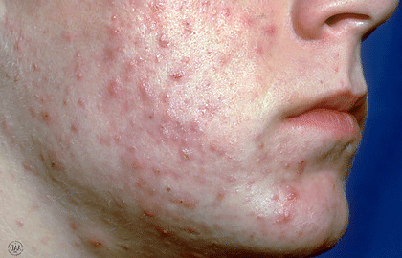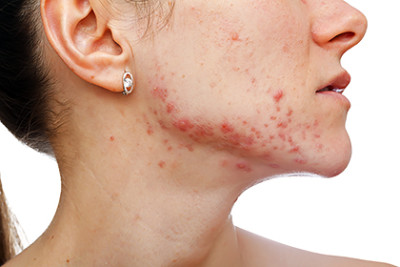What can clear severe acne?
If you wake up to find a few large pimples on your otherwise clear face, you may consider that severe acne. Likewise, a breakout of whiteheads and blackheads before a first date may seem like severe acne. But that’s not the type of acne we’re talking about here.
What is severe acne?

Severe acne causes breakouts that often extend deep into the skin. Called cysts and nodules, these breakouts tend to be painful. When severe acne clears, acne scars often appear.
You may also see many blackheads, whiteheads, or both when acne is severe.
Anyone who has severe acne knows how stubborn it can be. You cannot clear it with acne treatment that you buy at the store. To see clearing, you either have to wait it out or see a dermatologist. Waiting out severe acne can take years.
Benefits of treating severe acne
Living with severe acne can be tough on your psyche. Many studies have found that acne can lead to poor self-esteem, depression, or anxiety. People with acne may stop hanging out with friends and family. Going after a job promotion or trying out for a sport may no longer seem worthwhile.
Acne treatment can help. Many studies show that treatment for severe acne can:
Clear acne
Prevent new scars
Boost a person’s mood and self-esteem
How dermatologists treat severe acne
When a patient has severe acne, a dermatologist often recommends treating it with one of the following.
Antibiotic + medicine you apply to the acne: This is often the first treatment recommended for severe acne. Taking an antibiotic can reduce the redness and swelling of acne. The medicine you apply to your skin works on reducing bacteria and clogged pores.
If this treatment fails to clear your skin, your dermatologist may switch your antibiotic or talk with you about isotretinoin (eye-so-tret-eh-no-in).
Isotretinoin: This is a potent medicine that attacks all four causes of acne—bacteria, clogged pores, excess oil, and inflammation (redness and swelling). About 85% of patients see permanent clearing after one course of isotretinoin.
Due to possible side effects, you will need to carefully consider whether you want to take this medicine. If you decide to take isotretinoin, you must enroll in a monitoring program.
Birth control pill (females only): A birth control pill can be an effective part of an acne treatment plan. When treating severe acne, a birth control pill may be used along with an antibiotic or a medicine called spironolactone (spy-ren-no-lac-tone) to get the acne under control.
Give treatment time
Give your acne treatment time to work. It can take two to three months to see improvement.

If the pill may be an option for you, it’s important to tell your dermatologist about all of your medical conditions, including heart disease. Your dermatologist must weigh the risks of using a birth control pill to treat acne against the benefits.
Spironolactone (females only): This medication can also effectively treat severe acne in women. It reduces excess oil.
If this may be an option for you, be sure to tell your dermatologist about all of your medical conditions.
Acne removal: Your dermatologist can use a few different techniques to remove a large cyst or nodule.
One way your dermatologist can get rid of a painful cyst or nodule is to inject it with a corticosteroid. This helps to quickly reduce the size and pain.
Another procedure is called incision and drainage. It’s used to drain a large, painful acne cyst or nodule that medicine cannot clear. You should not try to drain a cyst or nodule at home. The risk of infection is great when done outside of a medical office.
Dermatologists use a procedure called acne extraction to remove whiteheads and blackheads that fail to clear with acne treatment.
Low-dose prednisone: This is a super-potent corticosteroid. Dermatologists prescribe it to treat a very serious type of severe acne called acne fulminans. It’s also used to treat pityrosporum folliculitis, an itchy, acne-like rash.
Maintenance plan helps keep skin clear
After you see clear (or nearly clear) skin, you still need acne treatment. However, the type of treatment may change. Most people can keep acne away with proper skin care and medicine they apply to their skin. Without this treatment, acne can return quickly.
Skin care plays key role
Even when treating acne, the right skin care is essential. Acne-friendly skin care can make the difference between seeing clearing and an acne flare. You’ll find skin care that dermatologists recommend at, Acne: Tips for managing.
No one needs to live with severe acne
While severe acne can be stubborn, it’s not impossible to get clearing. Thanks to advances in treatment, virtually all acne can clear with a dermatologist’s help.
Images
Severe acne: Image used with permission of the American Academy of Dermatology National Library of Dermatologic Teaching Slides.
Acne along jawline: Image from Thinkstock
References
Zaenglein AL, Graber EM, et al. “Acne vulgaris and acneiform eruptions.” In: Wolff K. et al. Fitzpatrick’s Dermatology in General Medicine, 7th edition. McGraw-Hill Companies, Inc., USA, 2008:696-700.
Zaenglein AL, Pathy AL, et al. “Guidelines of care for the management of acne vulgaris.” J Am Acad Dermatol. 2016;74:945-73.
 Atopic dermatitis: More FDA-approved treatments
Atopic dermatitis: More FDA-approved treatments
 Biosimilars: 14 FAQs
Biosimilars: 14 FAQs
 How to trim your nails
How to trim your nails
 Relieve uncontrollably itchy skin
Relieve uncontrollably itchy skin
 Fade dark spots
Fade dark spots
 Untreatable razor bumps or acne?
Untreatable razor bumps or acne?
 Tattoo removal
Tattoo removal
 Scar treatment
Scar treatment
 Free materials to help raise skin cancer awareness
Free materials to help raise skin cancer awareness
 Dermatologist-approved lesson plans, activities you can use
Dermatologist-approved lesson plans, activities you can use
 Find a Dermatologist
Find a Dermatologist
 What is a dermatologist?
What is a dermatologist?